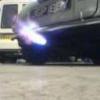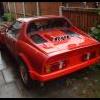
Rear Drum Brakes Not Bleeding
#1

Posted 03 June 2008 - 06:13 PM
the rear drums wont bleed, we have concluded this down to between the rear subby t piece and the master cylinder
any ideas what this could be? the line seems fine, the front brakes are working yet theres hardly any pressure on the brake pedal
brakes are our weak point so any suggestions or pinpoints would be helpful
cheers ma dears!
#2

Posted 03 June 2008 - 06:29 PM
#3

Posted 03 June 2008 - 06:30 PM
Just opening the bleed nipple and pumping the pedal doesn't always work until fluid is filling the lines, it tends to just go backwards and forewards..
open bleed nipple, press pedal, keep pressed, close bleed nipple, let pedal up.
keep repeating..do this on all wheels starting at furthest from master cylinder.
an easier option is an eezibleed this pressurises the system and forces fluid down the lines so you just go round and release each nipple in turn.
Edited by lrostoke, 03 June 2008 - 06:31 PM.
#4

Posted 03 June 2008 - 06:37 PM
when you get sigs of fluid jab the brake pedal crack the nipple (furthest away from the master cylinder first) to release the air, do so until there is only fluid coming out,
do the same on the other side
having a partner would be easier
#5

Posted 04 June 2008 - 12:21 PM
Just_jack, I don't wish to start an argument with you about "jabbing the pedal" but on the rear brakes that isn't always a good idea (depending largely on the age of the car). Older vehicles have a proportioning valve on the rear subframe. It's really a pressure limiting valve. IF you push the pedal too quickly and/or if the bleed nipple isn't open sufficiently, the valve closes prematurely and prevents fluid/air from being bled out of the rear wheel nipples. Slow and steady with Irostoke's method works regardless of what valve is on the rear subframe.
Of equal importance is the comment above about adjusting the drums. Go back to your car before doing anything else and try the pedal again. Lewis said there was hardly any pressure. Pump the pedal rapidly twice in succession. The first pump will obviously still feel "soft". IF the second pump is also "soft" and the pedal goes down just as far, you have a bleeding, shoe installation, or master cylinder problem. Either fluid is getting by the seals, you're compressing air in the lines, or the mechanical assembly is wrong (see below). If however, on the second pump the pedal is higher and firmer, you need to adjust your rear brakes before continuing. Proper adjustment of the rear drums is when an elevated wheel can be rotated by hand and you "hear" drag between the shoes and drum. The rotating wheel should stop spinning within a single revolution. If it keeps spinning and spinning and you don't hear a gentle scraping, the shoes are too loose.
Lewis, before leaving the subject of the rear brakes... why are you bleeding the brakes in the first place? Did you replace components or are you flushing the lines? More importantly, did you fit new rear shoes? It is critical that you put the brake shoes on in the correct position or you will NOT get a firm pedal no matter how much adjustment and bleeding you do. Please tell us more about what you've done.
#6

Posted 04 June 2008 - 05:36 PM
..Uhm... On my Mini, the bleed screws are UNDERNEATH the incoming pipe. Air rises, therefore technically it'd never get to the bleed screw. I had this happen on mine, and thought I had mounted them upside down..if you have a trolley jack, jack the back end of the car up with the nipple open that way the air will rise to the highest point
So, assuming that they're installed correctly, I'd have to second Doug's statements.. If you DO need to adjust the shoes, don't forget to verify the handbrake.
Edited by coyttl, 04 June 2008 - 05:40 PM.
#7

Posted 05 June 2008 - 03:47 AM
if it is an early model, then you might want to try bleeding the brake master cylinder first, by early i mean with no brake servo and a double brake master cylinder, bleed the top of the master cylinder.
to do this.
1 depress the brake pedal slowly.
2 undo the bolt on the top of the brake master cylinder.
3 tighten the bolt on the brake master cylinder.
4 release brake pedal
5 if you had air out of the bolt redo steps 1-4 if not goto step 6
6 depress the brake pedal sowly and undo the lower pipe union, point to note have a rag under the union to catch the excess fluid.
7 tighten the union and release brake pedal
8 if you had air repeat stes 6 and 7 if not goto 9
9 depress the brake pedal slowly and undo the top pipe union on the brake mster cylinder, again using a rag to catch the fluid.
10 tighten the union and release the brake pedal
11 if you had air the repeat if not bleed the brakes from the furthest point to the closest point,
an extra tip depress the pedal 2-3 times slowly then hold down before releasing the bleed screws.
hope this heps
#8

Posted 06 June 2008 - 10:29 AM
if you have a trolley jack, jack the back end of the car up with the nipple open that way the air will rise to the highest point
Don't mean to be awkward, but this will never work. A bubble of air in the line will never travel to the open nipple due to buoyancy, the only way to get the air out is to force it out together with the fluid.
#9

Posted 06 June 2008 - 10:32 AM
Its worth giving a go if you cant get it working.
#10

Posted 06 June 2008 - 10:42 AM
'n all relative.
Suck the air out with a syringe 'n bit of rubber hose. bleeding along the line by slackening the pipe unions sometimes helps too.
#11

Posted 06 June 2008 - 11:22 AM
#12

Posted 07 June 2008 - 11:38 PM
we managed to get them bleeding to the rear in the end and worked it down to alot of muck in the lines, we have also replaced the rear hoses aswell as i have a feeling they may of been internally swollen
some great techniques given!!
I second Irostoke's comments regarding the bleeding method. I'll make the additional comment that the method he describes is the traditional one and it involves two people. AND, you should push the pedal to the floor SLOWLY... very slowly.
Just_jack, I don't wish to start an argument with you about "jabbing the pedal" but on the rear brakes that isn't always a good idea (depending largely on the age of the car). Older vehicles have a proportioning valve on the rear subframe. It's really a pressure limiting valve. IF you push the pedal too quickly and/or if the bleed nipple isn't open sufficiently, the valve closes prematurely and prevents fluid/air from being bled out of the rear wheel nipples. Slow and steady with Irostoke's method works regardless of what valve is on the rear subframe.
Of equal importance is the comment above about adjusting the drums. Go back to your car before doing anything else and try the pedal again. Lewis said there was hardly any pressure. Pump the pedal rapidly twice in succession. The first pump will obviously still feel "soft". IF the second pump is also "soft" and the pedal goes down just as far, you have a bleeding, shoe installation, or master cylinder problem. Either fluid is getting by the seals, you're compressing air in the lines, or the mechanical assembly is wrong (see below). If however, on the second pump the pedal is higher and firmer, you need to adjust your rear brakes before continuing. Proper adjustment of the rear drums is when an elevated wheel can be rotated by hand and you "hear" drag between the shoes and drum. The rotating wheel should stop spinning within a single revolution. If it keeps spinning and spinning and you don't hear a gentle scraping, the shoes are too loose.
Lewis, before leaving the subject of the rear brakes... why are you bleeding the brakes in the first place? Did you replace components or are you flushing the lines? More importantly, did you fit new rear shoes? It is critical that you put the brake shoes on in the correct position or you will NOT get a firm pedal no matter how much adjustment and bleeding you do. Please tell us more about what you've done.
the basic reason we bled them was due to reffiting the master cylinder and using new brake fluid, the car had been sitting for a very long time and so could of really done with a full strip down and inspection, we first thought the master cylinder had called it a day, but after realising the amount of mess was in the lines we have seen the problem.
im really glad youve told me about not being too harsh on the pedal aswell, im used to just slamming the pedal down a few times you see
when you say the master cylinder could of gone, what would you usually say goes in them? is it the seals or the mechanism
also when would it be mandatory that you adjust the drums, just after reffiting new shoes/springs or a new rear cylinder or every service? because if its applicable now then i will remind him that they should be done.
i also have to start building up the brakes on my project so this has been a great help
#13

Posted 07 June 2008 - 11:44 PM
if you have a trolley jack, jack the back end of the car up with the nipple open that way the air will rise to the highest point
Don't mean to be awkward, but this will never work. A bubble of air in the line will never travel to the open nipple due to buoyancy, the only way to get the air out is to force it out together with the fluid.
yeah we tried that and im afraid it didnt make any difference, we also tried the technique of keeping the furthest bleed nipple from the cylinder (back left) open and leaving the pedal depressed overnight, still didnt make any difference
then again it was very gunky, we had to take the nipples out, blow them out clean, replace the rear hoses and even then it took a while
1 user(s) are reading this topic
0 members, 1 guests, 0 anonymous users

















